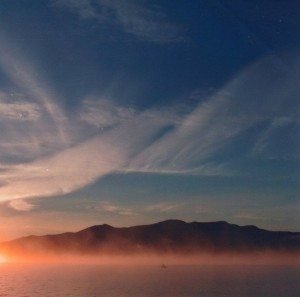WILMINGTON, Mass.—A worn bench. A pending storm. A beautiful lake and an old earring in one family’s heirloom.

All are everyday sites one might take for granted.
But for students at Wilmington High School, they can equate themselves to fragments of the Armenian Genocide in a most calculating project doled out by world history instructors Lisa Desberg and Maura Tucker. Take an ordinary photo and show how it may relate to the persecution suffered by Armenians in 1915.
In all, some 25 students took part in the picture project, shooting everything from a car whizzing through a stop sign to crab grass in someone’s lawn and a scenic landscape.
The latter is designed to represent hope and peace, as shown in the accompanying photo.
Wrote the student, “The sense of hope being portrayed through the sun and sky represents what the Armenian people are pursuing to get this tragedy recognized. What appear to be clouds in the photo may represent a dove which symbolizes peace.”
“Armenians are ultimately searching for the peace in the aftermath of this cruel slaughter of their population and need that closure to reach a standing of peace and happiness,” the quote resumed.
Two old earrings were pictured by another student once belonging to an immigrant and cherished to this day as a family heirloom.
“As my great grandmother passes these earrings down through generations after her, she did the same with stories,” another student outlined. “Many who survived this tragedy kept their traditions alive with their sentiments.”
An old barn is symbolic to another student envisioning the difficult living conditions her ancestors experienced. A door bolted shut was another student’s interpretation of “a forgotten genocide.”
“The Turks locked up their victims and put them behind rusty, forgotten doors before disposing of them,” this student wrote.
“Every storm runs out of rain,” was another’s interpretation of an impending storm over a marsh. “My photograph resembles the dark days of a genocide. Like any storm, we wait for it to pass before clear skies arrive.”
He presented his report over a tricolored backdrop representing the Armenian flag.
The study drew a myriad of emotions by the students, and in some cases a comparison to other genocides throughout history.
The class includes one Armenian, Jessica Kasparian, whose photograph shows her as a child in her great-grandfather’s arms.
“He lost his father during the genocide,” she wrote. “Then, he was brave enough to immigrate to America and create a new world for himself. Without him, I would not be alive today and my name would not live on.”
No sooner did the students complete this project that they launched another, writing letters to President Barack Obama and U.S. Congressman Edward Markey, imploring them to support recognition of the Armenian Genocide.
The assignment was the result of tutelage received from their instructors, along with material supplied by Facing History and Ourselves and the Armenian Genocide Education Committee of Merrimack Valley, which visits the school regularly.
“As an Armenian, it saddens me that there is no justice for my ancestors,” Kasparian wrote the president. “It is time the victims of such an awful crime get the recognition they deserve from a country that has a great leadership position in the world. Armenians must have their story told in classrooms so history will not repeat itself.”


Dear Wilmington High School: I want to commend your students for their thoughtful and touching project on the Armenian Genocide. I’m filled with great pride to learn so many young high school students have taken on such an important subject, as this is for Armenians. I would also like to take this opportunity, to dedicate and present to them, a copy of a book my late brother, Richard D. Kloian, published. It should pair well with the knowledge they’ve gained from Facing History and Ourselves, which my brother had also closely worked with as well. His book is titled, “The Armenian Genocide – News Accounts from the American Press: 1915-1922”. It’s not a history book, but a RECORD of HISTORY in the making. I like to refer to it as an archive of evidence.
To learn facts about him, his book and work, please visit these four key sites:
http://www.facinghistory.org/explore/upstanders/richard-kloian
http://asbarez.com/80591/founder-of-armenian-genocide-resource-center-richard-kloian-laid-to-rest/
http://armenianstudies.csufresno.edu/hye_sharzhoom/vol34/october12/1_kloian.html
http://www.genocideeducation.org/pr/2010/05_07_2010.htm
Thank you.
Sincerely yours,
Bernard Kloian
Canton, MI